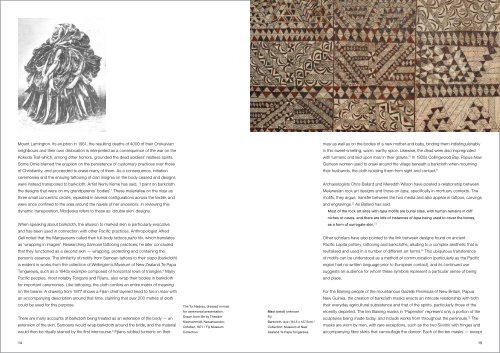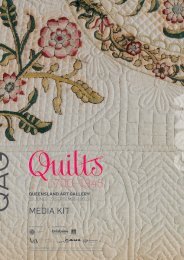Paperskin: barkcloth across the Pacific - Queensland Art Gallery
Paperskin: barkcloth across the Pacific - Queensland Art Gallery
Paperskin: barkcloth across the Pacific - Queensland Art Gallery
You also want an ePaper? Increase the reach of your titles
YUMPU automatically turns print PDFs into web optimized ePapers that Google loves.
Mount lamington. its eruption in 1951, <strong>the</strong> resulting deaths of 4000 of <strong>the</strong>ir Orokaivian<br />
neighbours and <strong>the</strong>ir own dislocation is interpreted as a consequence of <strong>the</strong> war on <strong>the</strong><br />
Kokoda Trail which, among o<strong>the</strong>r horrors, grounded <strong>the</strong> dead soldiers’ restless spirits.<br />
some Omie blamed <strong>the</strong> eruption on <strong>the</strong> persistence of customary practices over those<br />
of Christianity, and proceeded to erase many of <strong>the</strong>m. As a consequence, initiation<br />
ceremonies and <strong>the</strong> ensuing tattooing of clan insignia on <strong>the</strong> body ceased and designs<br />
were instead transposed to <strong>barkcloth</strong>. <strong>Art</strong>ist Nerry Keme has said, ‘i paint on <strong>barkcloth</strong><br />
<strong>the</strong> designs that were on my grandparents’ bodies’. 7 These materialise on <strong>the</strong> nioje as<br />
three small concentric circles, repeated in several configurations <strong>across</strong> <strong>the</strong> textile, and<br />
were once confined to <strong>the</strong> area around <strong>the</strong> navels of her ancestors. in reviewing this<br />
dynamic transposition, Modjeska refers to <strong>the</strong>se as ‘double skin’ designs.<br />
When speaking about <strong>barkcloth</strong>, <strong>the</strong> allusion to marked skin is particularly evocative<br />
and has been used in connection with o<strong>the</strong>r <strong>Pacific</strong> practices. Anthropologist Alfred<br />
Gell noted that <strong>the</strong> Marquesans called <strong>the</strong>ir full-body tattoos pahu tiki, which translates<br />
as ‘wrapping in images’. researching samoan tattooing practices, he later concluded<br />
that <strong>the</strong>y functioned as a second skin — wrapping, protecting and containing <strong>the</strong><br />
person’s essence. The similarity of motifs from samoan tattoos to <strong>the</strong>ir siapo (<strong>barkcloth</strong>)<br />
is evident in works from <strong>the</strong> collection of Wellington’s Museum of New Zealand Te Papa<br />
Tongarewa, such as a 1940s example composed of horizontal rows of triangles. 8 Many<br />
<strong>Pacific</strong> peoples, most notably Tongans and Fijians, also wrap <strong>the</strong>ir bodies in <strong>barkcloth</strong><br />
for important ceremonies. like tattooing, <strong>the</strong> cloth confers an entire matrix of meaning<br />
on <strong>the</strong> bearer. A drawing from 1877 shows a Fijian chief layered head to toe in masi with<br />
an accompanying description around that time, claiming that over 200 metres of cloth<br />
could be used for this purpose.<br />
There are many accounts of <strong>barkcloth</strong> being treated as an extension of <strong>the</strong> body — an<br />
extension of <strong>the</strong> skin. samoans would wrap <strong>barkcloth</strong> around <strong>the</strong> bride, and <strong>the</strong> material<br />
would <strong>the</strong>n be ritually stained by <strong>the</strong> first intercourse. 9 Fijians rubbed turmeric on <strong>the</strong>ir<br />
The Tui Nadrau, dressed in masi<br />
for ceremonial presentation.<br />
Drawn from life by Theodor<br />
Kleinschmidt, Natuatuacoko,<br />
October, 1877 / Fiji Museum<br />
Collection<br />
Masi (detail) unknown<br />
Fiji<br />
Barkcloth, dye / 94.5 x 127.5cm /<br />
Collection: Museum of New<br />
Zealand Te Papa Tongarewa<br />
masi as well as on <strong>the</strong> bodies of a new mo<strong>the</strong>r and baby, binding <strong>the</strong>m indistinguishably<br />
in this sweet-smelling, warm, earthy spice. likewise, <strong>the</strong> dead were also impregnated<br />
with turmeric and laid upon masi in <strong>the</strong>ir graves. 10 in 1920s Collingwood bay, Papua New<br />
Guinean women used to crawl around <strong>the</strong> village beneath a <strong>barkcloth</strong> when mourning<br />
<strong>the</strong>ir husbands, <strong>the</strong> cloth isolating <strong>the</strong>m from sight and contact. 11<br />
Archaeologists Chris ballard and Meredith Wilson have posited a relationship between<br />
Melanesian rock art designs and those on tapa, specifically in mortuary contexts. The<br />
motifs, <strong>the</strong>y argue, transfer between <strong>the</strong> two media and also appear in tattoos, carvings<br />
and engravings. 12 As ballard has said:<br />
Most of <strong>the</strong> rock art sites with tapa motifs are burial sites, with human remains in cliff<br />
niches or caves, and <strong>the</strong>re are lots of instances of tapa being used to cover <strong>the</strong> bones,<br />
as a form of surrogate skin. 13<br />
O<strong>the</strong>r scholars have also pointed to <strong>the</strong> link between designs found on ancient<br />
<strong>Pacific</strong> lapita pottery, tattooing and <strong>barkcloth</strong>s, alluding to a complex aes<strong>the</strong>tic that is<br />
revitalised and used in a number of different art forms. 14 This ubiquitous transference<br />
of motifs can be understood as a method of communication (particularly as <strong>the</strong> <strong>Pacific</strong><br />
region had no written language prior to european contact), and its continued use<br />
suggests an audience for whom <strong>the</strong>se symbols represent a particular sense of being<br />
and place.<br />
For <strong>the</strong> baining people of <strong>the</strong> mountainous Gazelle Peninsula of New britain, Papua<br />
New Guinea, <strong>the</strong> creation of <strong>barkcloth</strong> masks enacts an intricate relationship with both<br />
<strong>the</strong>ir everyday agricultural subsistence and that of <strong>the</strong> spirits, particularly those of <strong>the</strong><br />
recently departed. The ten baining masks in ‘<strong>Paperskin</strong>’ represent only a portion of <strong>the</strong><br />
sculptures being made today, and include works from throughout <strong>the</strong> peninsula. 15 The<br />
masks are worn by men, with rare exceptions, such as <strong>the</strong> two Siviritki with fringes and<br />
accompanying fibre skirts that camouflage <strong>the</strong> dancer. each of <strong>the</strong> ten masks — except<br />
14 15

















